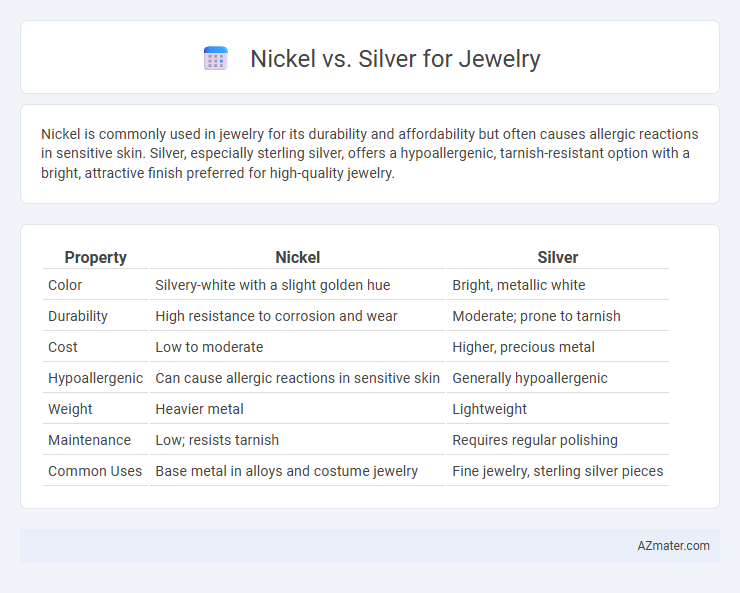Nickel is commonly used in jewelry for its durability and affordability but often causes allergic reactions in sensitive skin. Silver, especially sterling silver, offers a hypoallergenic, tarnish-resistant option with a bright, attractive finish preferred for high-quality jewelry.
Table of Comparison
| Property | Nickel | Silver |
|---|---|---|
| Color | Silvery-white with a slight golden hue | Bright, metallic white |
| Durability | High resistance to corrosion and wear | Moderate; prone to tarnish |
| Cost | Low to moderate | Higher, precious metal |
| Hypoallergenic | Can cause allergic reactions in sensitive skin | Generally hypoallergenic |
| Weight | Heavier metal | Lightweight |
| Maintenance | Low; resists tarnish | Requires regular polishing |
| Common Uses | Base metal in alloys and costume jewelry | Fine jewelry, sterling silver pieces |
Introduction to Nickel and Silver in Jewelry
Nickel is a durable, corrosion-resistant metal widely used in jewelry for its affordability and ability to create a shiny finish, but it often causes allergic reactions in sensitive skin. Silver, particularly sterling silver (92.5% pure silver alloyed with other metals), is prized for its bright luster, hypoallergenic properties, and versatility in fine and fashion jewelry. The choice between nickel and silver depends on factors like skin sensitivity, budget, and desired aesthetics, with silver generally preferred for its hypoallergenic qualities and timeless appeal.
Chemical and Physical Properties Comparison
Nickel is a hard, corrosion-resistant metal with a silvery-white appearance, known for its high melting point of 1455degC and excellent durability, making it suitable for jewelry that withstands daily wear. Silver, with a melting point of 962degC, is softer and more malleable than nickel, exhibiting superior electrical conductivity and a bright, lustrous shine that tarnishes over time due to oxidation. Chemically, nickel resists corrosion better in harsh environments, while silver's tendency to react with sulfur compounds leads to black tarnish, influencing maintenance requirements and aesthetic longevity in jewelry applications.
Visual Appearance and Aesthetic Differences
Nickel jewelry often features a sleek, modern look with a metallic gray sheen that complements contemporary fashion styles, while silver jewelry boasts a bright, reflective white luster prized for its classic elegance and timeless appeal. Silver's natural tarnish can develop a unique patina over time, adding character, whereas nickel maintains a consistent finish but may appear less lustrous. The aesthetic choice between nickel and silver depends on preference for either a durable, subtle shine or a traditional, radiant brilliance in jewelry pieces.
Durability and Longevity in Jewelry Use
Nickel is highly durable and resistant to wear, making it a common base metal in jewelry that withstands daily use without deforming or tarnishing quickly. Silver, particularly sterling silver, offers moderate durability but is softer and prone to scratches and tarnish over time, requiring regular maintenance to preserve its shine. For longevity, nickel alloys often outlast silver in everyday jewelry due to their robust hardness and corrosion resistance, although silver remains prized for its aesthetic appeal and can last for generations with proper care.
Affordability and Market Value
Nickel jewelry is significantly more affordable than silver, making it a popular choice for budget-conscious buyers, though its market value remains relatively low due to its commonality and allergenic potential. Silver, particularly sterling silver with 92.5% purity, commands higher market value due to its status as a precious metal, durability, and aesthetic appeal. While silver prices fluctuate with the global precious metals market, nickel prices remain stable but low, reflecting their differing roles in jewelry and investment value.
Allergic Reactions and Skin Sensitivity
Nickel is a common allergen in jewelry, often causing allergic reactions such as itching, redness, and swelling for individuals with sensitive skin. Silver, especially sterling silver (92.5% pure silver), is generally hypoallergenic and less likely to trigger skin sensitivity issues. Choosing silver jewelry reduces the risk of contact dermatitis compared to nickel-containing pieces, making it a safer option for those prone to allergies.
Tarnish Resistance and Maintenance Needs
Nickel jewelry is more prone to tarnishing due to its reactive nature, requiring frequent cleaning and polishing to maintain its shine. Silver offers greater tarnish resistance, especially when alloyed with elements like copper or coated with anti-tarnish layers, reducing maintenance efforts. Choosing silver over nickel can result in longer-lasting luster with less frequent upkeep, making it ideal for durable, low-maintenance jewelry.
Popular Uses in Contemporary Jewelry Designs
Nickel is widely used in contemporary jewelry for its durability and affordability, often found in fashion and costume pieces as a base metal or alloy. Silver, prized for its lustrous appearance and hypoallergenic properties, dominates fine jewelry designs including rings, necklaces, and earrings. While silver remains a top choice for luxury and heirloom-quality pieces, nickel's resistance to tarnish and cost-effectiveness make it popular in trendy, everyday wearable designs.
Environmental and Ethical Considerations
Nickel, widely used in affordable jewelry, often raises environmental concerns due to toxic mining practices and pollution, while its extraction can involve unethical labor conditions. Silver, though typically more expensive, is considered more sustainable as it often comes from recycled sources and has a lower environmental impact when mined responsibly. Ethical considerations favor silver when sourced through fair-trade certifications, reducing harm to both workers and ecosystems compared to unregulated nickel mining.
Choosing the Right Metal for Your Jewelry
Nickel is a durable, affordable metal commonly used in jewelry but can cause allergic reactions in sensitive individuals, making it less suitable for those with metal allergies. Silver, especially sterling silver, offers a hypoallergenic option with a bright, lustrous finish and is ideal for people seeking quality and elegance in their jewelry. Selecting the right metal depends on personal skin sensitivity, budget, and desired aesthetic, with silver often preferred for its hypoallergenic properties and timeless appeal.

Infographic: Nickel vs Silver for Jewelry
 azmater.com
azmater.com